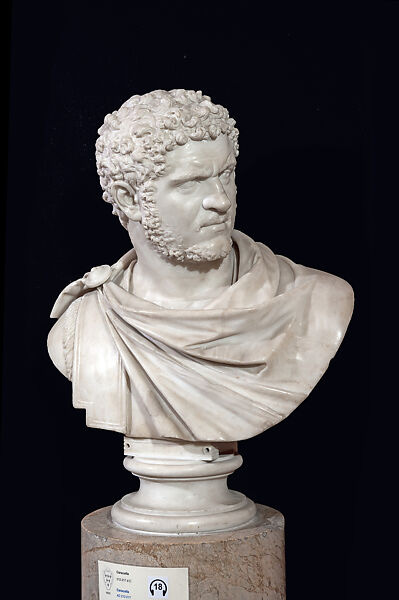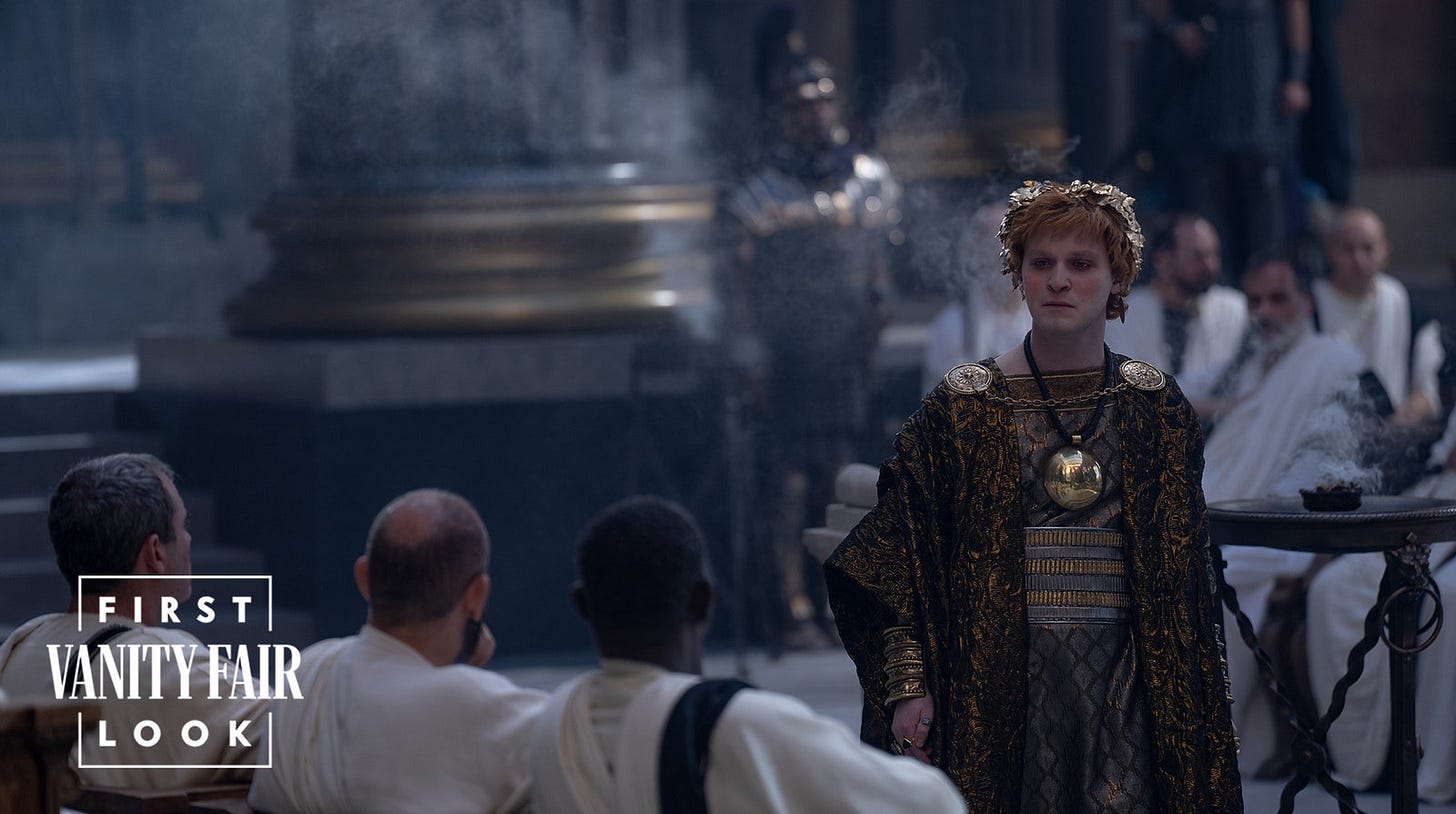Sinful Sunday: "Gladiator II" and the Decadent Appeal of Imperial Gender Deviance
The first photos from Ridley Scott's eagerly-awaited sequel suggests his return to ancient Rome will once again map anxieties about gender and sexuality onto the figure of the Roman emperor.
Hello, dear reader! Do you like what you read here at Omnivorous? Do you like reading fun but insightful takes on all things pop culture? Do you like supporting indie writers? If so, then please consider becoming a subscriber and get the newsletter delivered straight to your inbox. There are a number of paid options, but you can also sign up for free! Every little bit helps. Thanks for reading and now, on with the show!
Welcome to “Sinful Sundays,” where I explore and analyze some of the most notorious queer villains of film and TV (and sometimes literature, depending on my mood). These are the characters that entrance and entertain and revolt us, sometimes all three at the same time. As these queer villains show, very often it’s sweetly good to be bitterly bad.
As you’ve no doubt noticed here at Omnivorous, I have a bit of a fascination with the ancient world, particularly as it is represented in popular culture and, as I’m sure you’ve also noticed, I love queer villains in all of their nefarious forms. When those two things come together–as they have in several other installments of Sinful Sunday–well, you can imagine how excited I am.
Thus, you will not be surprised to learn that I was very excited when Vanity Fair released some of the first images from Ridley Scott’s Gladiator II, the long-awaited sequel to his blockbuster epic Gladiator. Those of us who love reception studies have spilled a lot of ink endlessly examining the British director’s take on the ancient world. While it takes some pretty egregious liberties with the historical record–no surprise, coming from Scott–there’s no question that Gladiator was and is both a great piece of epic filmmaking. It’s not going too far to say that it ignited a mini-revival of the ancient world epic (variously called peplum or sword and sandals or biblical spectacular) in the mid-to-late aughts. Everything from 300 to Rome to Spartacus owes a little something to Scott’s vision.
Judging by the new images that we’ve been given, the sequel is going to hit many of the notes as its predecessor. There will no doubt be a very virile and traditionally masculine gladiator, lots of violence in the arena and, of course, not one but two corrupt emperors who are leading the Empire down the road of destruction. Given that this is Ridley Scott we’re talking about–a director who never met a historical fact he couldn’t bulldoze into oblivion–I’m sure it’s going to take a number of egregious liberties with what we believe we know about the ancient world and those who lived it.
Indeed, one of the first things I noticed about the images was the extent to which neither Caracalla nor Geta looks anything like their ancient portraits. Not to be all pedantic, but the former made a point of having himself presented in ostentatiously martial guise, and if you’ve ever seen one of his busts, you can also see that he loved a scowl. While there are far fewer portraits of Geta–thanks in part to the fact that his brother had his memory blotted out after he murdered him–what we do have is likewise nothing quite like how he seems to appear in Gladiator II. Moreover, it seems more likely than not that the two co-emperors were not White–and certainly not the pale caricatures they are in these photos–given that their father, Septimius Severus, hailed from North Africa and their mother, Julia Domna, from a prominent family in Syria.
What’s even more fascinating to me, though, is the way in which these two men fit so neatly into the existing paradigms for Roman imperial decadence, at least as it has been reflected and refracted in popular culture. Ever since the silent era, Hollywood has made a point of mapping present anxieties about gender and sexuality onto those who held power in the ancient world. From Nero in films such as The Sign of the Cross and Quo Vadis to Caligula in The Robe and Commodus in Gladiator, we see time and again how Hollywood just can’t help but suggest that gender abnormality, often figured as excess or effeminacy, is synonymous with imperial degeneracy and decline.
With Gladiator II Scott certainly seems to have really leaned into the hedonism and effeminacy of it all, particularly when it comes to Caracalla. Just as Commodus in Gladiator was a far cry from the muscular and very masculine figure presented in both statuary and the historical record, so it seems that this divisive emperor is a pale shadow of the glowering soldier emperor that has come down to us from antiquity. One need no further than the way that the film’s version of the character looks like something out of a pantomime horror show, with his white makeup and blush, to say nothing of his gaudy accouterments, to see how we’re being asked to understand the emperor as weak and effeminate, hardly up to the task of keeping the imperial edifice together. Moreover, and just as importantly, it’s likewise clear that his dissolute appearance (and that of his brother) is going to be consistently and constantly opposed to the more traditional epic male trappings of Paul Mescal’s Lucius. As a genre the epic thrives on oppositions, and Scott knows this better than anyone.
Even though I haven’t seen anything confirming this, I think there’s a good chance that the ancient model for the film’s Caracalla is not the son of Septimius Severus but, instead, Elagablus (the grandson of the emperor’s sister-in-law, Julia Maesa). If you know anything about Elegabalus and his treatment in the historical record, you’ll no doubt know that for the Romans of his time he was one of the very worst to have ever worn the purple, largely because of his gender nonconformity and sexual excesses. The waifish Caracalla that we see in these stills from Gladiator II certainly seem to accord more with the extant images we believe to be of the tragic teenage emperor, and I strongly suspect that his behavior will, too.
Obviously all of this is highly conjectural, since we don’t even have a full trailer yet. However, I would not be at all surprised if Scott leans into the same epic film tropes that he did in the first film, and it’s not too much of a stretch to see shades of Commodus in both Caracalla and Geta. While some might ding it for this, I know I won’t be. I’ll be sitting right there on opening night, eagerly awaiting the chance to be swept away into the ancient Rome that Scott has already proven so adept at creating. He may not know much about the truth of history, but the man knows how to create a compelling and riveting piece of epic cinema, and that’s more than enough to get my butt to the theater.






